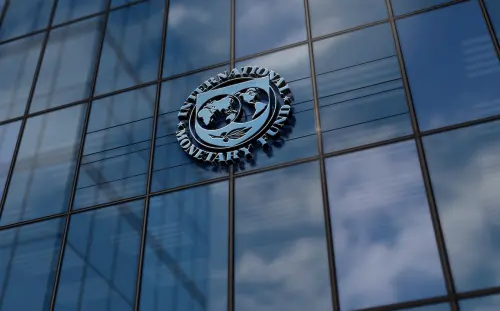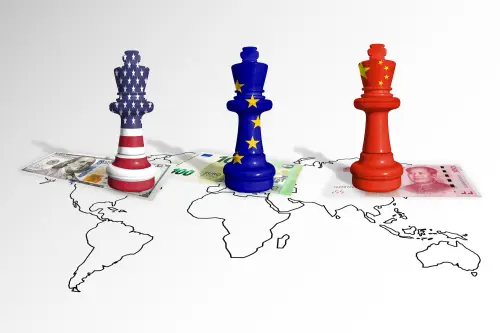The relationship between the U.S. and China has come to resemble an awkward pas de deux, with the two partners regularly stepping on each other’s toes. While the economic entanglements between the two countries have increased over the last decade, the number of flashpoints has increased as well.
Why is an economic relationship that is clearly important to both countries proving so hard to manage? The very nature of the dependence between these two economies makes it ripe for conflict. China remains highly dependent on U.S. export markets and continues to look to U.S. Treasury bond markets to park a large portion of its rapidly rising stock of foreign exchange reserves. The U.S. receives a large volume of low-cost imports from China and also gets help from China in financing a significant part of its budget and current account deficits.
China would like to tear itself away from the U.S. Treasury market but faces the prospect of a big capital loss on its large accumulated stock of holdings if U.S. Treasury bond prices were to rise or if the renminbi eventually appreciated in value against the U.S. dollar. The U.S. has become a lot less dependent on China’s financing of its deficits, particularly as the U.S. private saving rate has gone up and the current account deficit has fallen. Nevertheless, given the sheer scale of the U.S. deficit financing requirement—a budget deficit of about $1.4 trillion in 2009 and prospects of about $9 trillion of deficits over the next decade—sentiments in bond and currency markets are fragile. A precipitous action by China to shift out of U.S. dollar instruments (or even an announcement of such an intention) could act as a trigger that nervous market sentiments coalesce around, leading to a plunge in bond prices and the value of the U.S. dollar.
The bargaining strengths of the two countries are finely balanced. But this sets up a dangerous game of chicken that could easily spin out of control if the desire to pander to domestic audiences trumps rational collective policymaking in one or both countries.
This note provides a fuller picture of the tightening embrace between the two countries—in terms of flows of goods and services, financial capital and people—and the implications. The China-U.S. relationship is important not just for the principals but also for the broader world economy as the cooperative or conflicted nature of this relationship will set the tone for progress on a number of multilateral issues, including reform of the international monetary system and tackling climate change.
Trade in Goods and Services
The trade relationship between China and the U.S. has intensified over the past two decades, although the financial crisis has set this back slightly (see Figure 1). In 1985, trade between the two countries was modest and balanced. Since China’s accession to the WTO in 2001, which gave it greater access to the U.S. export market, growth in China’s exports to the U.S. has skyrocketed, with China’s exports now about five times the quantity of its imports from the U.S.
China’s exports to the U.S. are dominated by manufactured goods and by machinery and transportation equipment (see Figure 2). China’s imports from the U.S. are largely accounted for by machinery and transportation equipment and crude materials, inedible, mineral fuels, lubricants and related materials.
Trade in services between the two economies has been more modest than goods trade but has been rising sharply, with the main categories dominated by those that involve movement of people (travel, transportation, education; see Figure 3).
A central question is whether trade between the two economies has made them more important as mutual trading partners (see Figure 4). Interestingly, exports to the U.S. accounted for a relatively stable share of about 22 percent of China’s overall exports from 1999 to 2006. In 2007-08, the share of China’s exports going to the U.S. declined to about 18 percent. By contrast, the share of U.S. exports accounted for by China has been much smaller, leveling off at about 4 percent in the last couple of years.
These numbers probably understate the true importance of China’s dependence on the U.S. export market. In terms of sheer volume, U.S. imports still account for a significant share of world final consumption demand. Moreover, a great deal of intra-Asian trade is the result of expansion of cross-country supply chains. IMF analysis suggests that about one-third of the value added component of exports from Asia is still accounted for by the U.S. Thus, a slowdown in U.S. demand could lead to slower growth in other economies that export large quantities to the U.S. and thereby have indirect knock-on effects on Chinese export growth to those economies as well.
As a source of U.S. imports, China’s share has increased steadily, climbing to 13 percent of total U.S. imports by 2008. China’s dependence on U.S. imports, by contrast, has fallen over time, with imports from the U.S. accounting for about 9 percent of China’s imports in 2007-08.
A Matter of Balance
Many of the thorny issues in the bilateral relationship between these two countries can be traced to the evolution of the rising bilateral trade deficit that the U.S. runs with China. In 2008, the deficit of $268 billion with China amounted to over one-third of the overall U.S. trade deficit of $681 billion (see Figure 5).
The U.S. current account deficit, which had hit $800 billion in 2006, declined slightly in 2007-08 and the crisis-induced recession in the U.S. is expected to shrink the deficit to just under $400 billion in 2009. China’s current account surplus is expected to fall only slightly to about $372 billion in 2009. These developments in the trade and current accounts have kept the focus on China’s exchange rate regime.
Chinese currency policy, which involves heavy intervention in the foreign exchange market to prevent the currency (the renminbi) from appreciating, has resulted in a rapid rise in foreign exchange reserves (see Figure 6). After a tiny net increase in the first quarter of 2009, reserve accumulation has again picked up sharply in pace, with an additional accumulation of $256 billion from March to August (about $51 billion a month). This has increased the stock of China’s reserves to $2.2 trillion.
The balance of payments shows that a rising current account surplus, which has in turn been dominated by rising trade surpluses, accounts for a substantial fraction of the increase in reserve accumulation since 2005 (see Table 1). China’s international investment position has improved steadily, revealing a strong net asset position of $1.5 trillion at the end of 2008 (see Table 2). In other words, the value of China’s foreign assets now far exceeds the value of its external liabilities. Foreign exchange reserves account for about two-thirds of China’s gross foreign assets.
The exchange rate is a key relative price for international trade. China’s nominal exchange relative to the dollar was flat for a decade until July 2005, when there was a step appreciation of 2 percent of the renminbi relative to the U.S. dollar (see Figure 7). The renminbi has then racked up a cumulative nominal appreciation of 21 percent against the dollar. However, over the past 12 months, the renminbi has remained tightly pegged to the dollar, riding up with the U.S. dollar as it strengthened due to the safe-haven effect during the global financial crisis and down with the U.S. dollar since March 2009, when that effect began to wear off. This has reversed some of the appreciation of the trade-weighted measure of China’s real effective exchange rate, which is now up about 20 percent relative to its level in July 2005.
It is not easy to estimate the “equilibrium” value of the renminbi—the level it would settle at if China’s capital account was open and there was no government intervention in the foreign exchange market. The fact that the People’s Bank of China has consistently intervened in just one direction and by massive amounts—as indicated by its accumulation of foreign exchange reserves—suggests that the renminbi would appreciate significantly, conditional on capital outflows being relatively restricted, if China’s central bank stopped intervening in the foreign exchange market.
Financial Dependence Between China and the U.S.
Despite the notion of U.S. firms investing heavily in China, official foreign direct investment (FDI) flows from the U.S. to China peaked at $5.4 billion in 2002 and have remained at a level around $3 billion a year since 2005 (see Figure 8). This low number could partially be due to American companies’ use of offshore financial centers to channel FDI flows to China in order to gain some tax benefits. Nevertheless, all available data indicate that most FDI flows to China are from other Asian countries that are integrating their supply chains with China. FDI from China to the U.S. remains very modest.
The major financial link between the two countries remains Chinese purchases of dollar-denominated financial assets. China does not make public the currency denomination or composition of its foreign exchange reserves. U.S. data from the government’s Treasury International Capital System (TIC) database are potentially misleading as they capture the location rather than identity of a purchaser of U.S. instruments. For instance, China’s purchases of Treasury bonds routed through a U.K. bank would be counted as a purchase by a U.K. resident or institution. Notwithstanding these caveats, the TIC data capture some interesting trends.
About one-third of China’s holdings of foreign exchange reserves are in U.S. Treasury securities (see Table 3, Panel C). The real proportion is likely to be higher for the reasons noted above. It is intriguing that, even based on these data, the share of China’s reserve accumulation going into U.S. treasuries in 2008 was much higher than during the period 2004-07. During 2009, there has been enormous whipsawing from net sales to net purchases of U.S. treasuries, along with sharp shifts from Treasury bills (short term) to Treasury bonds (medium to long term) and back, with no discernible consistent pattern (see Table 3A).
Based on TIC and other U.S. data (see Table 4), it is possible to construct a profile of the owners of U.S. government debt held by the public, which stood at $7.4 trillion at the end of August 2009 (plus an additional $7.2 trillion of government-sponsored agency debt, which represents a liability of the U.S. government as well). China’s share of total outstanding government debt held by the public has risen steadily over the years and now stands at 11 percent, which is about one-quarter of all U.S. debt held by foreigners. China’s share of outstanding U.S. agency bonds was 6.4 percent in 2007 but fell below 6 percent in 2009.
In short, even based on official data that probably understate the true picture, China has contributed to a considerable proportion of U.S. debt financing and there are no indications from official data that this pattern has shifted drastically in recent months.
Movement of People
Along with flows of capital and goods, the flow of persons between the two countries has also increased rapidly (see Figure 9). The number of students coming from China to the U.S. has doubled since 1996. Chinese students now account for about nearly 13 percent of all foreign students in the U.S. The number of U.S. Study Abroad students going to China has also increased sharply from the early 2000s but from a much lower base. The number of immigrants from China admitted into the U.S. has followed a similar trend while the number of tourists from China (measured in person-days) has tripled since 1996.
Managing a Complicated Relationship
China and the U.S. are slowly adjusting to two major realities—their increasing mutual economic dependence and the rising heft of China on the global economic stage. While there has been a convergence between these two economies in some dimensions, in others there remains a yawning gap in economic terms (see Figure 10). In dollar terms, China’s per capita income is about one-tenth that of the U.S.; total private consumption in China is about $1.5 trillion compared to $10 trillion in the U.S. But China has a much bigger labor force, higher saving rates and far less public debt than the U.S.
China is slowly adjusting to its role as a major global economic power and still trying to find the right balance between asserting its authority and managing the responsibility that comes with being a major power. There are other economies that depend heavily on the U.S.—Canada and Mexico come to mind—but none of these has the heft of China or the desire and ability to become a world power in their own right. This creates a situation that is ripe for economic and geopolitical jockeying, with great potential for conflict even though both countries would stand to gain from a constructive relationship.
High-level policy dialogues such as the Strategic and Economic Dialogue and visits by each country’s leaders to the other are essential for improving each side’s understanding of the complicated political and social dynamics that drive policymaking in each country. Such understanding is essential to manage this relationship which could easily be derailed by marginal trade disputes over cars, chickens, steel pipes and tires. The problem is that these disputes with minor direct ramifications could spin out of control if pandering to domestic constituencies locks each nation’s leaders into a cycle of confrontation that escalates disputes to a more damaging level.
The two countries are locked in an ever-tightening embrace. Whether this embrace turns out to be a warm one or develops into a mutual choke-hold will have a big impact on the futures of these two economies and could also have ramifications for global financial and macroeconomic stability.
##1##
##2##
##3##
##4##
##5##
##6##
##7##
##8##
##9##
##10##
##11##
##12##
##13##
##14##
##15##
The Brookings Institution is committed to quality, independence, and impact.
We are supported by a diverse array of funders. In line with our values and policies, each Brookings publication represents the sole views of its author(s).



Commentary
An Awkward Dance: China and the United States
November 11, 2009